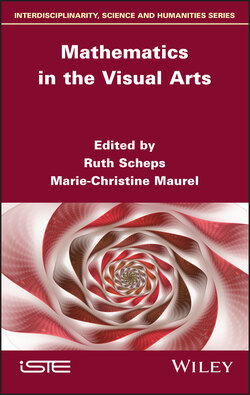Mathematics in the Visual Arts

Реклама. ООО «ЛитРес», ИНН: 7719571260.
Оглавление
Группа авторов. Mathematics in the Visual Arts
Table of Contents
List of Illustrations
Guide
Pages
Mathematics in the Visual Arts
Introduction
1. Infinity of God and Space of Men in Painting, Conditions of Possibility for the Scientific Revolution1. 1.1. A brief introduction to infinity
1.2. Infinity in painting and the invention of mathematical space
1.3. Geometrical optics and the subject in projective space
1.4. The limit of time, calculus and algebra
1.5. Rational spaces: from trade to physics
1.6. Settinga prioriconditions of representation and knowledge
1.7. Spaces of possibilities for the evolution of life?
1.8. Conclusion and opening: heterogeneous spaces of biological evolution
2. Geometry and the Life of Forms. 2.1. Introduction
2.2. Taking form
2.2.1.Early geometries
2.2.2.Geometrizing complexity
2.2.3.Morphogeneses
2.3. Art and geometry
2.3.1.Geometric art before its time
2.3.2.From geometric abstraction to digital art
2.3.3.Three legatees of geometric art. 2.3.3.1. Reuven Berman Kadim27
2.3.3.2. Emmanuel Van der Meulen29
2.3.3.3. Esther Stocker32
2.4. Beyond geometry
2.4.1.Quantic and cosmic
2.4.2.Outline and content
2.4.3.From form to the sublime
3. Among the Trees: Iterating Geneses of Forms, in Art and Nature
4. The Passion of Flight: From Leonardo da Vinci to Jean Letourneur. 4.1. Introduction: from legend to reality
4.2. Leonardo da Vinci and the basis of the theory of flight. 4.2.1.Chief engineer to Francis I of France
4.2.2.The flying propeller
4.2.3.Flapping-wing flight
4.2.4.Why can’t man fly like a bird?
4.2.5.The basis of Leonardo da Vinci’s theory of flight
4.3. Pioneers of the air and the first fluid movement visualizations. 4.3.1.Clément Ader (1841–1925), a distant successor of Leonardo da Vinci, invents the aeroplane
4.3.2.The oil king presides over the surge in flight
4.3.3.From Magnus to Lanchester: the difficult gestation of the theory of flight
4.3.4.Gustave Eiffel highlights the suction component of lift force
4.3.5.Étienne-Jules Marey takes the first images of fluid movement
4.4. From Henri Werlé to Jean Letourneur, the sculptor of fluid movement. 4.4.1.Henri Werlé or “the Master” of ONERA’s water tunnel
4.4.2.Jean Letourneur, interpreter of snapshots
4.4.3.As the 21st Century dawns, Jean Letourneur gathers momentum
4.5. Conclusion
4.6. Appendix: additions to the chapter entitled “Why Can’t Man Fly?”, which refers to the article by Marielle Vergès and Kamil Fadel (see footnote 15)
5. Sculptor of Fluid Movement
5.1. References
6. Internal Geometry of “Salvator Mundi” (The “Cook Version”, Attributed to Leonardo da Vinci) 6.1. Introduction
6.2. Distinctive features of the works of Leonardo da Vinci
6.3. Presentation of theSalvator Mundi,Cook version
6.4. Investigating the compositional mesh
6.5. Compositional format
6.6. Elements of the internal geometry of theSalvator Mundi, Cook version
6.7. A detailed look at the ellipses of the head of theSalvator Mundi
6.8. Visual consonance
6.9. Properties of the type 1 ellipse
6.10. Other applications of the type 1 ellipse
6.11. The decoration of two intersecting bands of the stole
6.12. The internal geometry of theSalvator Mundi(Ganay version)
6.13. Conclusion
6.14. References
7. Internal Geometry of a Night Scene by Georges de La Tour: “The Apparition of the Angel to St. Joseph” 7.1. Introduction
7.2. Methodology
7.3. Distinctive features of the work of Georges de La Tour
7.4. Internal geometry ofThe Appearance of the Angel to St. Joseph
7.5. The search for the compositional mesh
7.6. Compositional format
7.6.1.Position of the two protagonists’ heads
7.7. The compositional architecture
7.8. The ellipse of light
7.9. Curved or elliptical forms
7.10. Internal geometry of the two protagonists’ heads
7.11. Discussion
7.12. Compositional construction
7.13. Conclusion
7.14. References
8. Emergilience, an Art Research Project. 8.1. Background of the projectEmergilience. 8.1.1.Preamble
8.1.2.The artistic challenges
8.1.3.A little bit of art history
8.2. Description of theEmergilienceproject. 8.2.1.A continually developing research in progress
8.2.2.What has already been achieved?3. 8.2.2.1. Study of known models of emergence
8.2.2.2. Choice of algorithmic programming: MAS
8.2.2.3. Generative animations
8.2.3.Future developments. 8.2.3.1. Resilience phenomena
8.2.3.2. The work as a complex living system
8.3. Let us finish with a conclusion that looks to the future
8.4. References
List of Authors
Index. A, B, C
D, E, F
G, H, I
L, M, P
R, S, T
U, V
WILEY END USER LICENSE AGREEMENT
Отрывок из книги
Series Editor
.....
Since the emergence of non-Euclidean geometries and new branches of physics (quantum and relativistic) that point to the importance of chance, or even uncertainty, in the material world, we have seen a gradual erasure of the boundaries between the logical understanding of phenomena and the intuitive approach. Max Bill’s Mathematical Art represents a culmination of this convergence.
In the wake of conceptual art, digital art has driven the dematerialization of artwork still further. Now that a painting is nothing but a signal, devoid of any meaning of its own, the work’s significance has shifted upstream, in other words, to its production processes, the algorithms or the thought processes that generated it.
.....